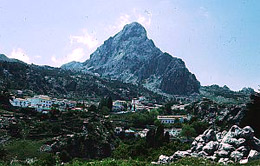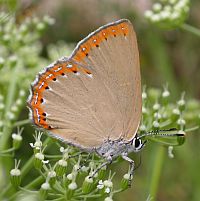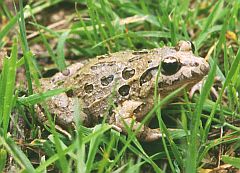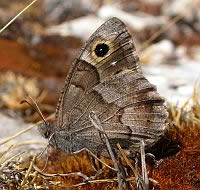 |
Superbly scenic limestone mountains in western Andalucía, harbouring an important enclave of Spanish fir forest, sizeable griffon vulture colonies, abundant Spanish ibex and a rich flora, including many endemic species.
 Grazalema village
© Teresa Farino
Grazalema village
© Teresa Farino
The spectacular limestone massif of the Sierra de Grazalema is one of Andalucía's prime destinations for nature lovers. It was the first Biosphere Reserve to be declared in Spain, in 1977, and is also a parque natural of 53,439ha. Although these mountains reach a maximum height of just 1,654m (at Torreón, sometimes called El Pinar), Grazalema is the westernmost of the Sierras Béticas, separated from the Atlantic only by a low-lying coastal plain, such that it intercepts the lion's share of the rainfall of the region: an average of 2,230mm. This gives Grazalema the dubious distinction of being the rainiest place in Spain but, more importantly, means that flowers bloom well into the summer, unlike in many other parts of Andalucía.
As a result of long-term karstification of the limestone, the terrain is distinctly rugged, characterised by
 Spanish Purple Hairstreak
Spanish Purple Hairstreak
Laeosopis evippus
© Teresa Farino
sheer cliffs, scree slopes, precipitous gorges and a complex network of subterranean galleries; one of these - the Hundidero-Gata complex - is more than 5km long and harbours one of the largest winter bat roosts - principally Schreiber's - in Europe: in excess of 100,000 individuals. Around the edges of this rocky core lie fertile plains, clothed in sweeping expanses of cork, western holm and Lusitanian oak dehesa, with some more remote slopes harbouring enclaves of primeval Mediterranean forest, while the rivers harbour well-developed gallery forests of narrow-leaved ash, small-leaved elm, southern nettle tree and Mediterranean buckthorn, associated with thick belts of purple, olive and Mediterranean willows and oleander.
Flora and fauna of Grazalema
Almost 1,400 taxa of vascular plant have been recorded within the park, including six narcissi, seven irises and around 30 species of orchid. Of the total, around 150 are Afro-Iberian endemics and 13 are confined to the Serranía de Ronda and the Sierra de Grazalema, while four taxa are unique to Grazalema itself. Of greatest botanical significance, however, is the relict Spanish fir forest - the pinsapar - which here covers around 420ha on the shady north-facing slope of the Sierra del Pinar. -
|
Some of the more notable endemic plants of the Sierra de Grazalema & the Serranía de Ronda
|
|---|
| |
| Papaver rupifragum • | Phlomis x margaritae • |
| Saxifraga bourgeana ¤ | Linaria huteri ¤ |
| Echinospartum algibicum • | Linaria platycalyx ¤ |
| Erodium recoderi • | Cirsium gaditanum ¤ |
| Omphalodes commutata ¤ | |
| |
¤ = plants found in both the Serranía de Ronda and Grazalema;
• = plants confined to Grazalema
|
Grazalema's floristic diversity is matched by a rich vertebrate fauna, with around 220 species having been recorded in the park. Outstanding among the 150 species of bird cited here are the 320 pairs of griffon vultures which breed here - one of the largest concentrations in Spain, if not the whole of Europe - mainly in the ravines of the Garganta Seca and Garganta Verde in the northern part of the park, although you can see these birds cruising around in search of a meal over a radius
 West Iberian Painted Frog
West Iberian Painted Frog
Discoglossus galganoi
© Teresa Farino
of many kilometres. Other cliff-breeding raptors include a dozen or so pairs of Egyptian vulture and Bonelli's eagle, as well as eagle owl and peregrine, which share this habitat with choughs and alpine swifts. White-rumped swifts are also known to breed in the park, notably around the northern village of Zahara de la Sierra, on the edge of the Embalse de Zahara, where red-rumped swallows - whose nests they utilise - abound.
Among the mammals pride of place must go to the Spanish ibex, which colonised Grazalema from the nearby Sierra de las Nieves in the 1970s; two stable populations inhabit the park today, in the Sierra de Líbar, on the extreme southern edge, and around the peaks of the Sierra del Pinar, where they descend to take refuge in the pinsapar in winter and poor weather. Roe deer have also arrived here relatively recently, this time from Los Alcornocales to the south, while red and fallow deer have both been introduced to private estates as game species, particularly around the Embalse de los Hurones. Most of the typical Mediterranean forest predators are also present, including western polecat, beech marten, Eurasian badger, wildcat, common genet and Egyptian mongoose. In total some 40 species of mammal are known to inhabit the park, while amphibians (11 species) and reptiles (17 species) are also well-represented, including Bedriaga's skink and west Iberian painted frog, both of which are Iberian endemics.
 Tree Grayling
Tree Grayling
Hipparchia statilinus
© Teresa Farino
The butterflies of the area are also of interest, with the Spanish fir forest's long list of records including notable species such as mallow, tufted marbled and sage skippers, both swallowtails, black-veined white, large tortoiseshell (often on the wing from February onwards), cardinal, many fritillaries - Niobe, Queen of Spain, Provençal, knapweed, marsh - two-tailed pasha, dusky heath, Spanish and southern gatekeepers, rock and tree graylings, nettle-tree butterfly, Spanish purple and Provence hairstreaks, long-tailed and Panoptes blues and Spanish brown argus. Around the 1103m Puerto del Boyar (on the A-372) you could expect to find Spanish fritillary, Lorquin's and false baton blues, with dusky meadow brown, purple-shot copper (here subspecies boyarensis) and African grass blue later in the year; other blues to look out for around Grazalema are osiris, Iolas and green-underside.
|
 Tree Grayling
Tree Grayling 








